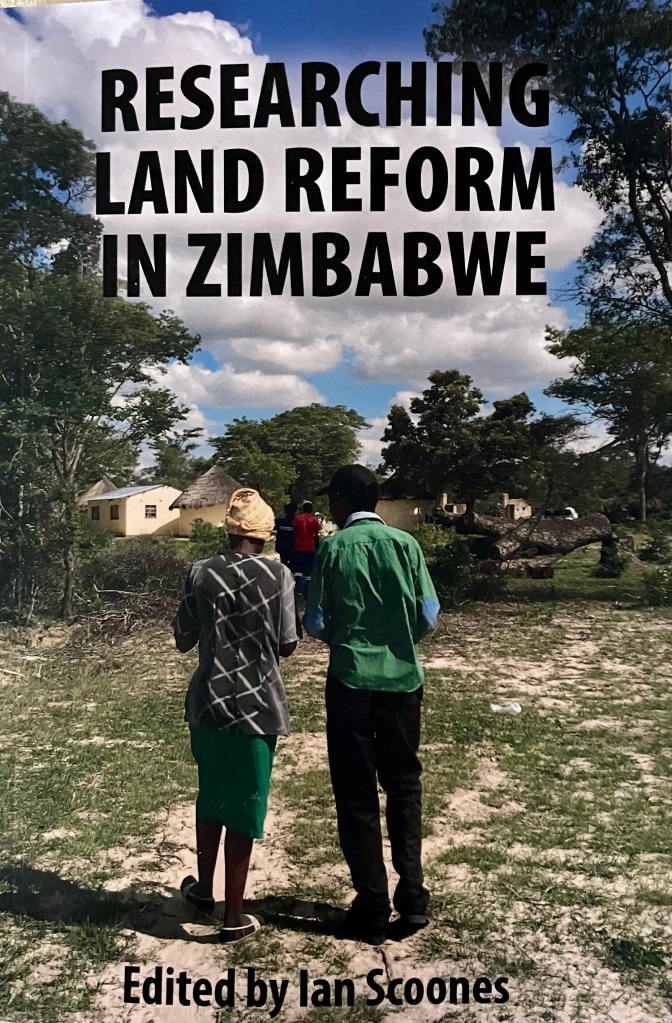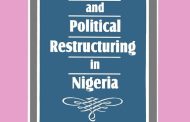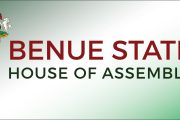Between 2000 and 2003, Zimbabwe land reform conflict was one of the hottest issues in global politics, not as hot as 9/11 and the invasion of Iraq only because Zimbabwe is not an oil producing country. But it is debatable if there was any other foreign policy issue as tense, tasking and testing of the African sensibility in diplomacy for the Nigerian, South African and Zimbabwean foreign affairs ministry operatives. Well, two decades thereafter, the truth has come out Mugabe was not everything he was said to be.
Interestingly, it is well-heeled Western scholars such as Prof Ian Scoones who have led the process of exploding the lies when many of their African counterparts were overstressing how Mugabe had lasted too long in power or how he should have been more tactful and so on.
Although the state of siege in Nigeria makes it difficult to be happy, this book is a source of fulfillment and happiness for anyone who had any level of involvement with that conflict from the guerrilla farms in Zimbabwe to the several Commonwealth Ministerial Action Group, (CMAG) meetings in London over it. Up to 2002, then President Obasanjo was very much on top of the situation and Alhaji Sule Lamido, his foreign affairs minister, made brilliant presentations at CMAG meetings. Thabo Mbeki handled things very well especially at the February 2002 Commonwealth Heads of Government Meeting, (CHOGM) in Australia. Kant must be right: time can settle many things!
And this comes as a free book for all along with this review piece as extracted from the University of Sussex’s Institute of Development Studies platform!
Researching Land Reform in Zimbabwe is a new book compiling 20 articles our team has published over the last 20 years. All the chapters bar one have appeared as peer-reviewed journal articles, with the material covering the period from early land invasions in 2000 to more recent developments. All the articles are available, many as open access, but there was a demand to have these all in one place.

The late President Mugabe
The book is available for free as a pdf, or via Amazon as and e-book (£0.99) or a print copy (£10.68) if you want it for your shelves and with a nice cover! It’s a bit of a bargain as we charge no royalties and this is just printing/hosting costs! It’s a hefty tome, coming in at nearly 600 pages, and weighing more than a kilo. I know this because at least half my baggage allowance on my flight last week to Harare was taken up by books. These are now being distributed around university and institute libraries across the country. Access to literature remains a challenge in Zimbabwe as elsewhere in Africa, and even open access material cannot necessarily be easily downloaded if internet speeds are slow. So, as with previous books of ours, we are trying to make physical copies available in libraries…. Old fashioned I know, but important in my view!
Most of the chapters are co-authored outputs, based on the work of an incredibly dedicated team. The core team started working together in the late 1980s, under the aegis of the then Farming Systems Research Unit of the Department of Research and Specialist Services of the Ministry of Agriculture. Under the leadership of the late BZ Mavedzenge, we kept working together on various topics and, following 2000, focused on land reform experiences, starting in Masvingo. Sadly, BZ passed away prematurely in 2017 and Felix Murimbarimba has since led the team, supported by long-standing team member, Jacob Mahenehene. Jacob Chaumba, Easther Chigumira, Nelson Marongwe, Toendepi Shonhe, Chrispen Sukume and William Wolmer among others have also been part of the research team at different points linked to different projects. Over the years, we have also worked with many field assistants, very often agricultural extension workers based in the field sites, and their inputs have been immensely important for the overall research effort. While this book focuses on the research by our team, the work is complemented by that of many others. For it is this wider corpus of work, conducted in the context of a vibrant research community working land and agriculture in Zimbabwe that continues despite the challenges.
There are 20 chapters in the book organised across six themes:
- ‘Experiences of land reform’ presents our overarching data on what happened to people’s livelihoods in different sites in Masvingo province over time.
- ‘Political contestations’ highlights the changing political dynamics emerging in our sites, resulting from different trajectories of accumulation and so social differentiation.
- ‘People and places’ looks at particular groups of people – such as young people and farm labour – and locates their experience in the wider land reform story and certain places, including small towns in farming areas.
- ‘Production and markets’ examines particular commodities – notably livestock, tobacco and sugar – and investigates changes in production systems, including through farmer-led irrigation.
- ‘Environmental dynamics’ and touches on the contests over land in wildlife areas and the impacts of foot-and-mouth disease in a new agrarian setting.
- ‘Land reform in the wider context’, touching on broader questions of long-term rural development and what is the meaning of ‘viability’ in the Zimbabwean farming context.
Much of this work has already appeared as blogs on Zimbabweland, where published papers are shared or the ideas tested out before writing an academic article. But the final papers are a more polished product, situated in wider academic debates about agrarian change.
What are some of the overarching conclusions that emerge from all this work? They are difficult to summarise as there are differences across sites, between people and over time, but the listing below, taken from the newly written introduction to the book, offers some headlines.
- Farmers on the new resettlement areas are producing and accumulating from investments in agriculture. Patterns vary widely between farms and across years, but a distinct pattern of ‘accumulation from below’, particularly in the A1 smallholder land reform sites, is seen. However, political and economic conditions over the past 20 years have seriously limited opportunities for most.
- Farmers who gained access to land during the land reform came from many different backgrounds. In the A1 smallholder areas, the majority were previously poor, small-scale farmers from the communal areas or were un(der)employed in nearby towns. In the A2 areas, there was a mix of those who applied through the formal route (mostly civil servants, including teachers and agricultural ministry staff) and those who gained access to land through patronage arrangements,, drawing on close connections with the party and security services. Outside this latter group, which is a small minority, the beneficiaries were not ‘cronies’, nor even necessarily ruling party supporters.
- Many of the new farmers are investing in their farms. First this was focused on land clearance and building new homes, but since this has extended to investing in new technology (notably irrigation pumps), as well as tractors and diverse forms of transport for marketing. Some are able to invest off-farm and there has been a growth in investment in real estate in nearby towns, especially in the tobacco-growing areas.
- Over time, there has been a distinct process of social differentiation, within both smallholder (A1) and medium-scale (A2) farms, with some accumulating, while others struggle. This results in new social relations between farms and between sites, as those who are not surviving from farm-based income must seek employment on other farms or develop off-farm income- earning options.
- There are major contrasts between A1 and A2 farms in all of our sites. A1 smallholder farms have performed relatively well, often producing surpluses, with investment flowing back to the farms or supporting relatives in other areas, including the communal areas and towns.
- A2 farms have by contrast struggled. As larger medium-scale operations, they require finance and capital investment, and this has been difficult to secure due to lack of bank finance or government support. Beyond a few years when the economy stabilised, the economic conditions over the past 20 years have not been conducive to successful farm business investment. That said, some have managed, and again there is substantial differentiation among A2 farms.
- The spatial restructuring of rural economies through land reform has resulted in new patterns of economic activity, with the sharing of labour, equipment and other resources across A1, A2 and communal areas. The concentration of locally-based economic growth driven by agriculture has had important effects on small towns, and many of these have grown significantly.
- During the land reform, resident farm labour on farms, especially in the high-potential areas, largely lost out on the allocation of new land. Farm labour has had to reincorporate in a new agricultural economy and has faced many challenges. Gaining access to even small pieces of land is crucial for survival, as the demand for labour varies and the working conditions are poor.
- Now over twenty years on from land reform, there is a next generation of young people who are seeking out agriculture-based opportunities. They may benefit from subdivision of their parents’ land, but many must survive on small patches. Investment in small-scale irrigation through the purchase of small pumps and, linked to horticulture production, is a favoured activity.
- Finance for agriculture is extremely limited, constraining opportunities for small- and medium-scale resettlement farmers alike. Banks have so far rejected either permits to occupy in the A1 areas and leases in the A2 areas as a basis for lending. State investments have been limited, and are often misdirected and subject to corruption. Western donors have not supported land reform areas as these are deemed ‘contested areas’ and so are effectively subject to ‘sanctions’.
- The dynamics of agriculture is highly dependent on the type of crop. Some crops, such as tobacco and sugar, are linked to contract finance arrangements, supported by private companies. This allows farmers to invest in their production and some have been highly successful, although the terms of the contracts are not always favourable. Other crops, including grain crops and most horticulture, require self-financing or reliance on very selective government schemes, and so are more challenging business propositions; although again there are important successes, notably around small-scale irrigated horticulture.
- The contrasts between A1 and A2 areas and the differentiation of farmers within each mean that there is a highly heterogeneous farming population. There are different classes of farmer emerging, ranging from emergent rural capitalists to petty commodity producers to diverse classes of labour, only partly reliant on agriculture. This results in a new politics of the countryside, with quite volatile political affiliations.
- The new agrarian structure, centred on a smallholder-based agriculture and complemented by medium-scale farms, requires a very different policy approach to agriculture, with new forms of support, including a revamped and revived agricultural administration system to encourage investment. Economic and political instability, combined with wider sanctions, has massively restricted the potential of land reform farmers to drive rural economic growth, but the potentials are clearly apparent, along with many, on-going challenges.
I hope you enjoying reading the articles – or even reading them again. Do let those who might find the material useful know about where to buy the book or download it.
ORIGINAL SOURCES
The following lists the original sources of each of the chapters in the six sections of the book after the introduction. Those articles that are published open access are reproduced under Creative Commons licenses, while others are either author submitted versions or are reproduced with permission.
Experiences of land reform (chapters 2-5)
Scoones, I., N. Marongwe, B. Mavedzenge, F. Murimbarimba, J. Mahenehene, and C. Sukume. 2011. Zimbabwe’s land reform: challenging the myths. Journal of Peasant Studies, 38(5), 967–993.
Scoones, I. 2016. Land reform, livelihoods and the politics of agrarian change in Zimbabwe. In: Pallotti, A., Tornimbeni, C. (eds.), State, Land and Democracy in Southern Africa, 127–149. London: Routledge.
Scoones, I., N. Marongwe, B. Mavedzenge, F. Murimbarimba, J. Mahenehene, and C. Sukume. 2012. Livelihoods after land reform in Zimbabwe: understanding processes of rural differentiation. Journal of Agrarian Change, 12(4), 503–527.
Shonhe, T., I. Scoones, and F. Murimbarimba. 2020. Medium-scale commercial agriculture in Zimbabwe: The experience of A2 resettlement farms. The Journal of Modern African Studies, 58(4), 601–626.
Political contestations (chapters 6-8)
Chaumba, J., I. Scoones, and W. Wolmer. 2003. From jambanja to planning: the reassertion of technocracy in land reform in south-eastern Zimbabwe? Journal of Modern African Studies, 41(4), 533–554.
Scoones, I. 2015. Zimbabwe’s land reform: new political dynamics in the countryside. Review of African Political Economy, 42(144), 190–205.
Scoones, I., J. Chaumba, B. Mavedzenge, and W. Wolmer. 2012. The new politics of Zimbabwe’s Lowveld: struggles over land at the margins. African Affairs, 111(445), 527–550.
People and places (chapters 9-11)
Scoones, I., B. Mavedzenge, F. Murimbarimba, and C. Sukume. 2019. Labour after land reform: The precarious livelihoods of former farmworkers in Zimbabwe. Development and Change, 50(3), 805–835.
Scoones, I., B. Mavedzenge, and F. Murimbarimba. 2019. Young people and land in Zimbabwe: livelihood challenges after land reform. Review of African Political Economy, 46(159), 117–134.
Scoones, I. and F. Murimbarimba. 2020. Small towns and land reform in Zimbabwe. The European Journal of Development Research, https://doi.org/10.1057/s41287-020-00343-3.
Production and markets (chapters 12-15)
Mavedzenge, B.Z., J. Mahenehene, F. Murimbarimba, I. Scoones, and W. Wolmer. 2008. The dynamics of real markets: cattle in southern Zimbabwe following land reform. Development and Change, 39(4), 613–639.
Scoones, I., B. Mavedzenge, F. Murimbarimba, and C. Sukume. 2018. Tobacco, contract farming, and agrarian change in Zimbabwe. Journal of Agrarian Change, 18(1), 22–42.
Scoones, I., B. Mavedzenge, and F. Murimbarimba. 2017. Sugar, People and Politics in Zimbabwe’s Lowveld. Journal of Southern African Studies, 43(3), 567–584.
Scoones, I., F. Murimbarimba, and J. Mahenehene. 2019. Irrigating Zimbabwe after land reform: The potential of farmer-led systems. Water Alternatives, 12(1), 88–106.
Environmental dynamics (chapters 16-17)
Wolmer, W., J. Chaumba, and I. Scoones. 2004. Wildlife management and land reform in south-eastern Zimbabwe: a compatible pairing or a contradiction in terms? Geoforum, 35(1), 87–98.
Scoones, I. and W. Wolmer. 2007. Land, landscapes and disease: the case of foot and mouth in southern Zimbabwe. South African Historical Journal, 58(1), 42–64.
Land reform in the wider context (chapters 18-20)
Scoones, I., B. Mavedzenge, and F. Murimbarimba. 2018. Medium-scale commercial farms in Africa: the experience of the ‘native purchase areas’ in Zimbabwe. Africa, 88(3), 597–619.
Mushongah, J. and I. Scoones. 2012. Livelihood change in rural Zimbabwe over 20 years. Journal of Development Studies, 48(9), 1241–1257.
Cousins, B. and I. Scoones. 2010. Contested paradigms of ‘viability’ in redistributive land reform: perspectives from southern Africa. Journal of Peasant Studies, 37(1), 31–66.
This blog was written by Ian Scoones and originally appeared on Zimbabweland




























